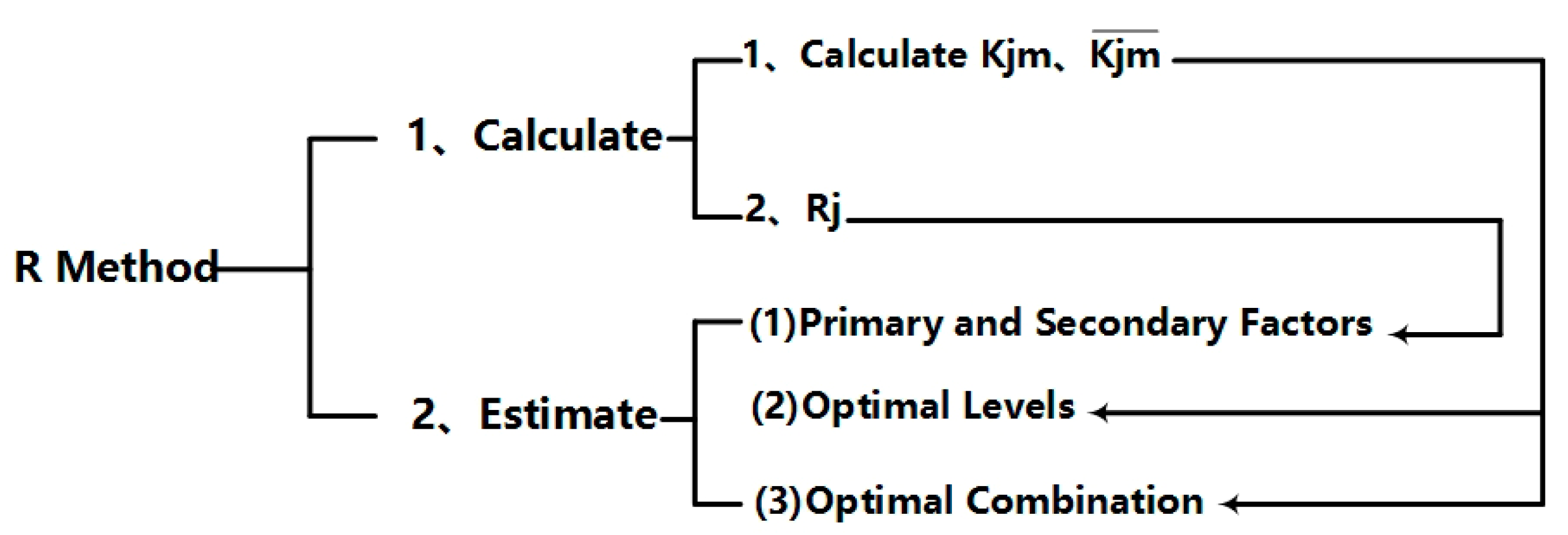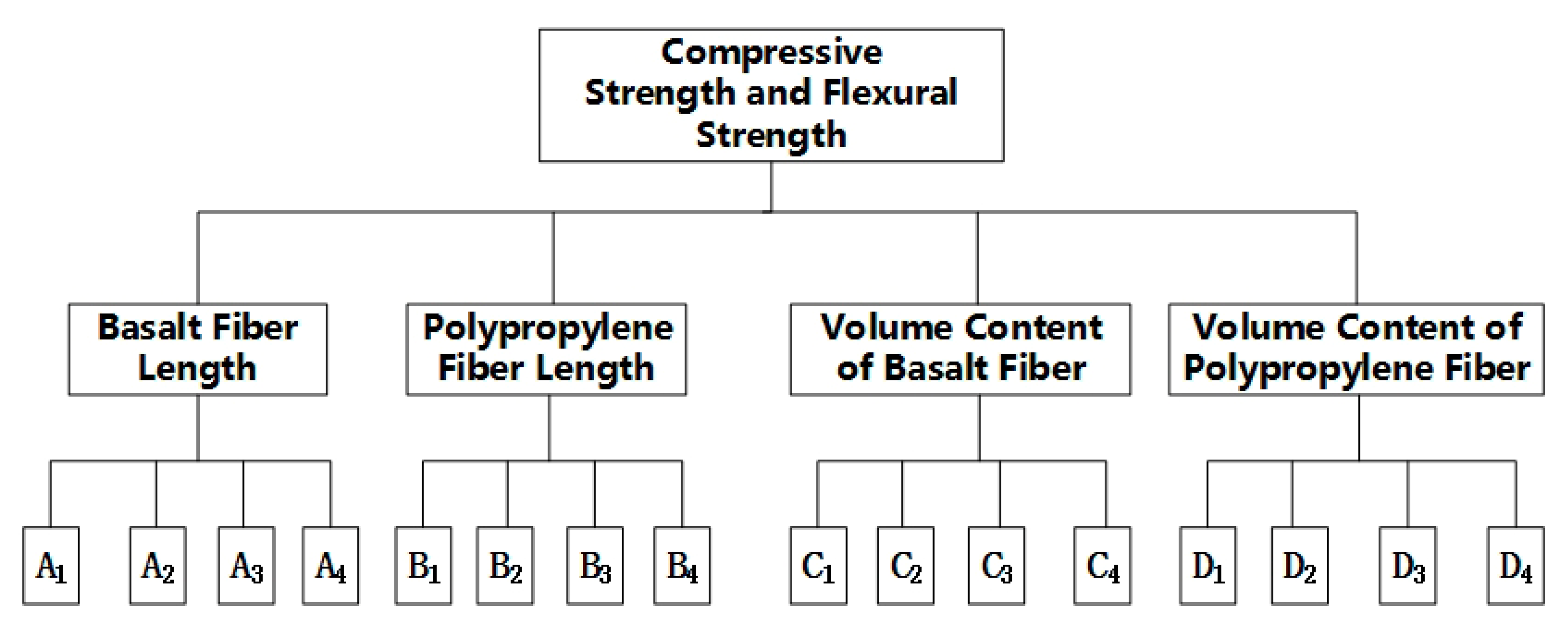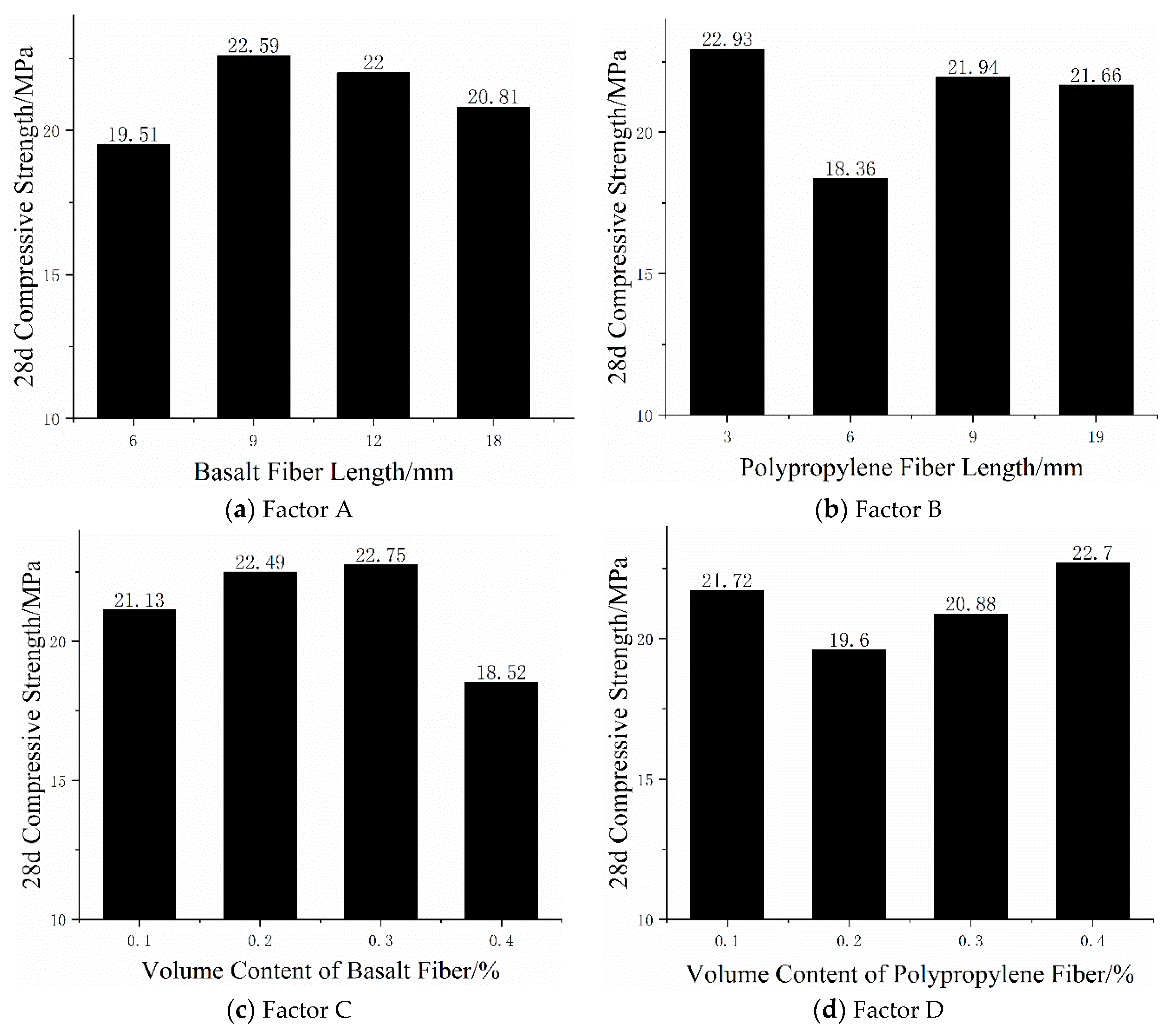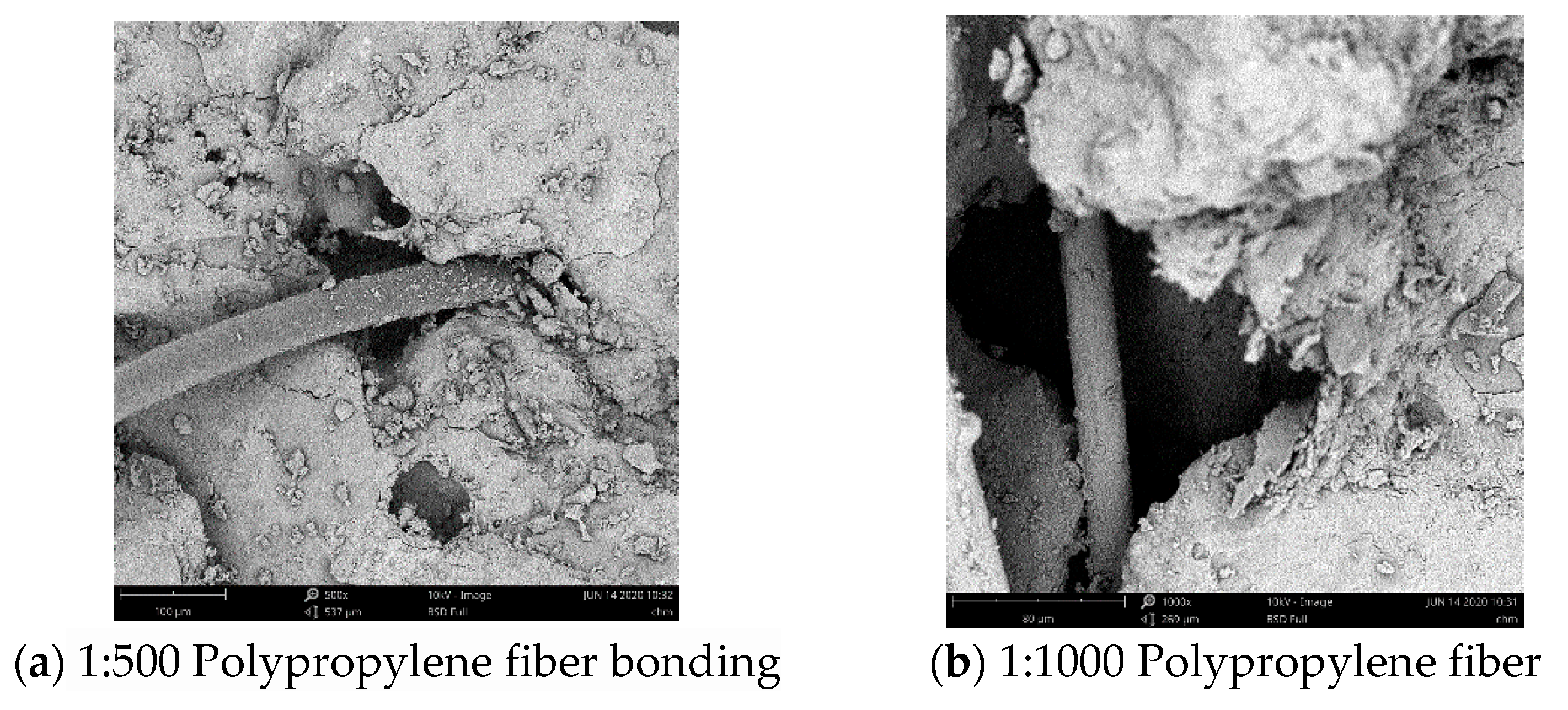3.2. Range Analysis
The range analysis method was referred to as R method, which distributes the multi-factor and multi-level test evenly through fewer test times, so as to improve the test efficiency [
27]. It consists of calculating and judging, as shown in
Figure 1.
Among them,
was the sum of test indexes
yjm corresponding to m level in column factor
j.
Kjm was the expected value of
yjm, that is, the average value of
yjm,
Rj was the range of the column
j factor, same as, the difference between the maximum value and the minimum value of the index value at each level of the column
j factor.
According to the size of , the optimal level of j factor and the optimal level combination of each factor can be judged, that is, the optimal combination. The magnitude of Rj can be used to judge the variation range of test indexes when the level of the factors in column j changes. The larger Rj, the greater the influence of this factor on the test index and therefore the more important it is. Therefore, according to the size of the extremely poor Rj, the primary and secondary factors can be judged.
According to the data in
Table 5, range analysis of each orthogonal test was carried out to obtain the range table of orthogonal test, as shown in
Table 6.
As can be seen from the data in
Table 6 that the influence of various factors on the 28 d compressive strength of mortar specimens was as follows—polypropylene fiber length > basalt fiber volume content > polypropylene fiber volume content > basalt fiber length. The influence of each factor on 28 d flexural strength was as follows—basalt fiber volume fraction > polypropylene fiber length > basalt fiber length > polypropylene fiber volume fraction. The 28 d strength effect of mortar specimens was compressive strength > flexural strength, which indicates that the fracture strength and elongation of fibers play a pulling role in the specimens. As shown in
Figure 2, the specimen can still remain in its original state when it was damaged and the fiber filaments can also be clearly seen at the crack to be connected at both ends of the crack.
3.3. Hierarchical Analysis of Orthogonal Test
Analytic Hierarchy Process (AHP) is a method of hierarchical analysis of complex problems [
28]. It combines with orthogonal experiments and analyzes indexes, factors and levels hierarchically to determine the influence weight of each factor on each index and selects the best scheme among many factors and levels. And the AHP model for the orthogonal test was illustrated in
Figure 3.
As shown in
Figure 3, the orthogonal test was divided into three layers. The first layer was the test index, namely compressive strength and flexural strength; the second layer was the factor (
A(i)), namely basalt fiber length (
A(1)), polypropylene fiber length (
A(2)), basalt fiber volume content (
A(3)), polypropylene fiber volume content (
A(4)) and the third layer was the factor level, namely each factor was divided into four levels. From left to right, let’s call that
,
,
,
,
,
,
,
,
,
,
,
,
,
,
,
.
The sum of the test data at the level of column
j of factor
A(i) was denoted as
Kij, which was called the effect of column
j of factor
A(i) on the test (
i = 1, 2, ...,
k;
j = 1, 2, ...,
nk). The effect weight was calculated by Equations (4)–(7).
A represents the horizontal layer which affects the test effect matrix;
C represents the influence of factors on the experiment weight matrix. The influence weight of each factor level on the test index was calculated as:
w =
ASCT, it indicates the influence of various factors and levels on the test indexes [
29].
Using this model computed the relative weighting of every factor level and the results was shown in
Table 7.
As shown in
Table 7, for compressive strength, the four horizontal weights of basalt fiber length were similar but A1 (6 mm) has the largest weight, B1 (3 mm) has the largest weight among the four levels of polypropylene fiber length, C4 (0.4%) has the largest weight among the four levels of basalt fiber volume content and D1 (0.1%) has the largest weight among the four levels of polypropylene fiber volume content. For flexural strength, the four horizontal weights of basalt fiber length are similar but A1 (6 mm) has the largest weight, B2 (6 mm) has the largest weight among the four levels of polypropylene fiber length, C4 (0.4%) has the largest weight among the four levels of basalt fiber volume content and D4 (0.4%) has the largest weight among the four levels of polypropylene fiber volume content. The fibers form a three-dimensional random mesh support structure in the cement matrix and the surface area per unit volume increases due to the increase of the volume content, thus reducing the spacing between the fibers and the more cement matrix wrapped on the surface of the fibers, the fibers can bear the stress generated by the volume deformation of the cement matrix.
3.4. Factor Index Analysis
According to the orthogonal test method, the 28 d compressive strength and flexural strength investigated are called indexes. The average strength of each factor at each level can be obtained from the visual analysis table, as shown in
Figure 4 and
Figure 5.
As can be seen from
Figure 4a, when the basalt fiber length increased from 6 to 9 mm, the compressive strength of mortar specimens increased by 15.79% but the basalt fiber length increased from 9 to 18 mm and the compressive strength of mortar specimens decreased by 7.88%. When the basalt fiber length increased from 9 to 12 mm, the compressive strength decreased by 2.61%, from 12 to 18 mm and decreased by 5.41%. As can be seen from
Figure 5a, when the basalt fiber length increased from 6 to 9 mm, the flexural strength of mortar specimens increased by 1.86% but when the basalt fiber length increased from 9 to 18 mm, the flexural strength of mortar specimens decreased by 3.66%. When the basalt fiber length increased from 9 to 12 mm, the flexural strength decreased by 2.44%, from 12 to 18 mm and decreased by 1.25%. According to the above analysis, the best choice of basalt fiber length for compressive strength and flexural strength was 6–9 mm. Both compressive strength and flexural strength show a trend of increasing first and then taking effect with the increase of basalt fiber length. Analysis shows that the reason for this phenomenon was that the basalt fiber length was too short or too long will limit the crack suppression of cement mortar and cannot effectively play a bridging role in mortar. Compared with long fibers, short fibers can be more evenly dispersed in mortar and better disperse and transfer the energy of mortar in hand, so as to improve the mechanical properties of mortar.
As can be seen from
Figure 4b, when the length of polypropylene fiber increased from 3 to 6 mm, the compressive strength decreased by 19.93%, from 6 to 9 mm, the compressive strength increased by 19.50%, from 9 to 19 mm and the compressive strength decreased by 1.28%. As can be seen from
Figure 5b, when the length of polypropylene fiber increased from 3 to 9 mm, the flexural strength of mortar specimens increased by 4.57%, the length of polypropylene fiber increased from 3 to 6 mm, the flexural strength increased by 3.59%, the length increases from 6 to 9 mm and the flexural strength increased by 0.94%. However, the length of polypropylene fiber increased from 9 to 19 mm and the flexural strength decreased by 0.96%. From the above analysis, the best choice of polypropylene fiber length for compressive strength and flexural strength index was 6–9mm. From the analysis of the above phenomena, it can be seen that when the length of polypropylene fiber was too short, the distribution inside the mortar will be uneven, which will reduce the compactness of the mortar, thus affecting the compressive strength and flexural strength. However, excessively long polypropylene fibers tend to agglomerate in mortar and cannot normally exert its strong tensile strength, which makes some mortar ineffective, thus reducing the flexural strength of mortar.
As can be seen from
Figure 4c, the compressive strength of mortar specimens increased first and then decreases with the increased of basalt fiber volume content. When the volume content of basalt fiber increased from 1% to 3%, its compressive strength increased by 7.67%. Among them, the content increased from 1% to 2%, the compressive strength increased by 6.43%, from 2% to 3% and the compressive strength increased by only 1.16%. However, when the volume content increased from 3% to 4%, the compressive strength decreased by 18.59%. As can be seen from
Figure 5c, the volume content of basalt fiber increased from 1% to 3% and the flexural strength of mortar specimens increased by 6.12%. Among them, the content increased from 1% to 2%, the flexural strength increased by 3.84%, from 2% to 3% and the flexural strength increased by 2.2%. However, the volume content increased from 3% to 4%, while the flexural strength decreased by 4.13%. From the above analysis, it can be seen that the best choice of basalt fiber volume content for compressive strength and flexural strength index was 2%–3%. The compressive strength and flexural strength of fiber mortar show a trend of increasing first and then decreasing with the increase of basalt fiber length, which shows that a reasonable fiber content was conducive to the improvement of compressive strength and flexural strength and a negative hybrid effect will occur if the fiber content was too high. The reason was that basalt fiber was properly added and the fiber can be evenly dispersed in the mortar to form a little bonding force with the mortar, thus producing an effective crack resistance effect. In addition, the random support system formed by fibers and mortar bear the load together, effectively improving the stress form of cement-based materials and improving the compressive strength and flexural strength.
As can be seen from
Figure 4d, the polypropylene fiber content increased from 1% to 2% and the compressive strength of mortar specimens decreased by 9.76% but the polypropylene fiber content increased from 2% to 4% and the compressive strength of mortar specimens increased by 15.82%. When the polypropylene fiber content increased from 2% to 3%, the compressive strength increased by 6.53%, from 3% to 4% and the compressive strength increased by 8.72%. When the content of polypropylene fiber was too small, the reinforcing effect of fiber in mortar will not be formed, so the compressive strength of mortar will not be greatly improved. Due to the good crack resistance ability of polypropylene fiber, the compressive strength of mortar increases gradually with the increasing content of polypropylene fiber. However, when the content of polypropylene fiber was too high, polypropylene fiber was easy to agglomerate in mortar, which makes the void inside mortar larger and the fine aggregate was unevenly distributed in mortar, resulting in the decrease of mortar compactness, thus reducing the compressive strength. As can be seen from
Figure 5d, when the volume content of polypropylene fiber increased from 1% to 2%, the flexural strength increased by 2.53%, from 2% to 3%, the flexural strength increased by 0.62%, from 3% to 4% but the compressive strength decreased by 1.58%. With the increase of polypropylene fiber content, the flexural strength of mortar increases first and then decreases. The reason for this phenomenon was that polypropylene fiber has high tensile strength. The addition of polypropylene fiber will improve the brittleness and toughness of cement mortar, enhance the cohesiveness between cement mortar and aggregate and thus improve the flexural strength. The same too much fiber content was easy to agglomerate in mortar, which cannot give full play to its function of preventing crack formation and expansion, resulting in the reduction of flexural strength. From the above analysis, we know that the best choice of polypropylene fiber volume content for compressive strength and flexural strength index was 2%–3%.
3.5. Analysis of Variance
The range analysis method has been carried out previously but since the range analysis method cannot estimate the error in the test process and the test result determination and cannot distinguish the data fluctuation caused by the change of test conditions from the data fluctuation caused by the error, in order to make up for this shortcoming, the variance analysis method was adopted to distinguish the difference and error in the test result caused by the change of factor level. At the same time, the contribution rate analysis can further confirm the influence of factors on indicators [
30]. The results of 28 d compressive strength, variance of flexural strength and contribution rate of various factors and errors were shown in
Table 8 and
Table 9.
From
Table 8, it can be seen that basalt fiber length, polypropylene fiber length, basalt fiber volume content and polypropylene fiber volume content have significant effects on 28 d compressive strength of mortar specimens. However, polypropylene fiber length was the main factor affecting the compressive strength of mortar specimens, basalt fiber volume content was the second, followed by polypropylene fiber volume content, basalt fiber length has the smallest effect, which was consistent with the results of range analysis. At the same time, polypropylene fiber length has the greatest influence on the 28 d compressive strength and its contribution rate reaches 33.12%, which was far greater than the data fluctuation caused by errors. The volume content of basalt fiber was 32.93%, which was much larger than the data fluctuation caused by error. The contribution currency of polypropylene fiber volume content and basalt fiber length is also larger than the data fluctuation caused by errors but the contribution ratio of basalt fiber length was the smallest among the four.
From
Table 9, it can be seen that the influence of various factors on the flexural strength at 28 d was as follows—the volume content of polypropylene fiber was the largest, the length of polypropylene fiber was the second, the length of basalt fiber was the third and the volume content of polypropylene fiber was the smallest, which is consistent with the result of range analysis. The influence of four factors on flexural strength was shown as follows—volume content of polypropylene fiber, polypropylene fiber length and basalt fiber length were all significant, while volume content of polypropylene fiber was influential. In the mixing process, the contribution ratio of polypropylene fiber volume content was 32.08% at the maximum, which was 32 times of the error. The contribution ratio of polypropylene fiber length was 26.18%, which was 26 times of the error contribution ratio. The contribution ratios of basalt fiber length and polypropylene fiber volume content were 15.8% and 9.72% respectively, which were 15 and 9 times of the error contribution ratio.
3.6. Efficacy Coefficient Analysis
The efficacy coefficient method can comprehensively evaluate multi-objective problems. According to the orthogonal test results, the maximum and minimum values of 28 d compressive strength value and flexural strength value were selected as the satisfactory value and impermissible value of the efficacy coefficient method index evaluation system [
31]. The specific values were shown in
Table 10.
According to the satisfactory value and impermissible value of each index, the efficiency coefficient value of each index was calculated and the formula is following:
According to the calculation result of efficacy coefficient, the best performance for the compressive strength was specimen 12 and its ratio combination was A4B1C2D4; for the flexural strength, the best performance was specimen 14 and its ratio combination was A2B2C4D4. According to the comparison of the total efficacy coefficient values, the total efficacy coefficient score of test piece 14 was the highest, which was 95.38. Therefore, combining the three strength indexes, the best matching combination was A2B2C4D4. Compared with the blank test piece, the compressive strength of test piece 14 was increased by 27.04% and the flexural strength was increased by 49%.
3.7. The Action Mechanism of Fiber
An appropriate amount of polypropylene fiber was mixed into cement mortar to form a uniform three-dimensional random support system, which can reduce segregation and bleeding of the mixture and the bridging effect of polypropylene fiber can also limit further crack propagation during cracking process. When the fiber content is too large, the fluidity of the mixture will decrease rapidly and the matrix will be hard to be compacted. Basalt fibers form a spatial grid structure inside the mixture structure, which plays a role on supporting aggregates, reducing segregation and bleeding of the mixture and can also inhibit the propagation of microcracks in the matrix through bridging. Due to the small diameter of basalt fibers, the fibers are easy to intertwine with each other during the dispersion process in cement mortar, resulting in “agglomeration”.
Due to the large gap in diameter and elastic modulus between polypropylene fiber and basalt fiber, the two fibers can form a “gradation” when they were reasonably matched, thus forming a more uniform and dense spatial network structure in the mixture, weakening the unfavorable conditions in the mixing and forming process and limiting the generation and development of shrinkage microcracks and plastic settlement cracks in the hardening process. In the loading process, basalt fiber firstly limited the propagation of microcracks. As microcracks fuse and coalesce into larger cracks, the basalt was gradually pulled out. In this process, polypropylene fiber also gradually played the bridging and bearing role, which limited the further growth of the crack. Finally, the overall performance of the cement matrix was improved by the combination of the two fiber and produce a positive hybrid effect.
The simultaneous incorporation of the two fibers into the cement matrix will increase the total amount of fibers, which may lead to poor workability of the mixture, thus reducing the compactness of the cement matrix. In addition, if the mixing content of polypropylene fiber and basalt fiber was unreasonable, the two fibers will affect each other in the mixing process, resulting in uneven fiber dispersion or intertwining, agglomeration and formation of more weak areas, thus greatly reducing the compactness of cement matrix, which will degrade its various mechanical performance indexes and produce negative hybrid effect.
3.8. Microscopic Mechanism Analysis
This paper summarizes the previous research results and analyzes the reasons for the strength of fiber-reinforced cement-based materials from the microstructure with the aid of Phenom scanning electron microscope (SEM).
Figure 6 and
Figure 7 respectively reflect the bonding and internal porosity of basalt fiber and polypropylene fiber with cement-based materials under different magnification.
As can be seen from
Figure 6, basalt fiber spans the cracks in the matrix, combines with slurry with monofilament finer than polypropylene, has a good combination form with mortar and the surface was wrapped with a large amount of cement colloid to make up the pores at the bonding place, further inhibiting the generation and expansion of microcracks and improving the mechanical properties of mortar and the crack resistance of fiber mortar. As can be seen from
Figure 7, polypropylene fibers were uniformly distributed in the cement-based material in a monofilament shape, which plays a bridging role and anchoring role on the material structure. Discontinuities with larger pores and microcracks in the cement-based material were often weak in strength. Polypropylene fibers can be used as connecting materials to bridge discontinuities at both ends, reducing the occurrence of microcracks and enhancing the strength of the cement-based material. Because basalt fiber and polypropylene fiber were high elastic modulus fiber and low elastic modulus fiber respectively, the two fibers play the role of inhibiting microcrack propagation at different levels. When the tensile stress was low, micro cracks appear in the cement-based material and polypropylene fibers vertically distributed in the stress section bear the tensile stress transmitted by the cracks. With the increase of the tensile stress, polypropylene fibers were pulled or pulled out and become invalid. At this time, the tensile stress between cracks was borne by basalt fibers, the crack propagation speed decreases and the strength of fiber mortar was improved.











